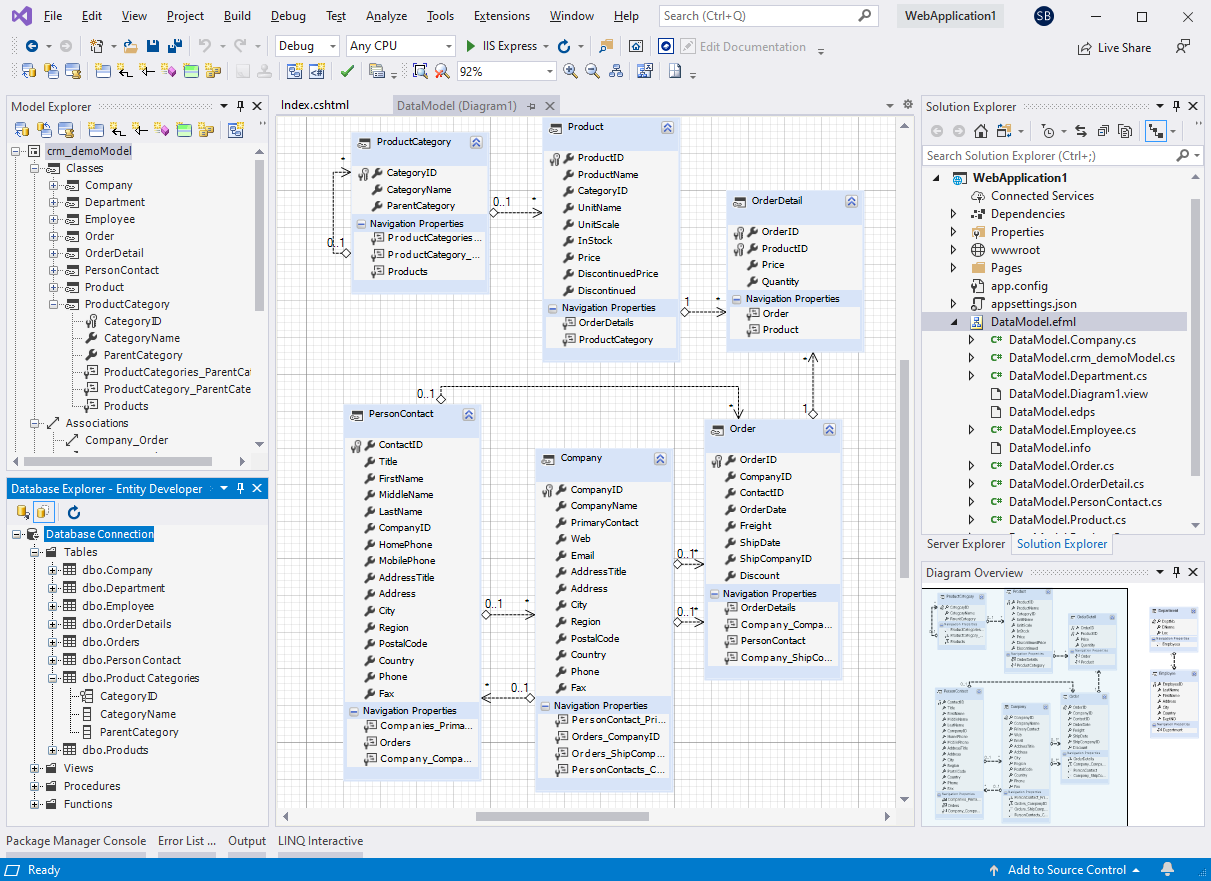Entity Developer VS Spring Boot
Entity Developer is an ASP .NET Core script that makes entity modeling with LinqConnect and ADO.NET Entity Framework a cinch. You can use it to create an entity model from scratch or modify the one you already have, in which case you will have the classes and the relationships with just a couple of clicks.
Entity Framework ORM aims to increase the developer’s productivity by reducing redundant tasks of augmenting the data used in the applications.
Spring Boot is one of the best frameworks for developing backend programs that are relied on by app developers. It’s a Spring-based framework, so developers can use it to write production-caliber Java EE applications written in Java.
Spring Boot not only assists developers in creating applications that just run but also allows for creating applications that can run without requiring external web server help. Spring Boot enables Phase Initialization to automatically embed a Tomcat or Netty server, depending on the programming languages used.
Features comparison
Entity Developer
- Generating Model from Database via Wizard
Entity Data Model Wizard helps entities be generated from the top of the table with the help of Entity Data Model in Visual Studio Entity Data Models. Entity Developer supports Wizard-based model generation from the database table for the Entity Framework and all of the supported ORMs. Entity Developer’s Create Model Wizard provides more functionality than the EDM, including automatically detecting tags. - Dragging Tables to Model Diagrams
LINQ to SQL models functions in Entity Developer includes generating entities from database tables with Create Model Wizard and dragging database tables from Database Explorer to the diagram for all the supported ORM developers. - Easy Updating Model from Database
To make a model using the Database-First approach, you may need to make changes to your database and then reflect these changes in your model. With Entity Developer, you can use the Update From Database Wizard which allows you to synchronize your model with the database for all your supported ORMs (Object Relational Mapping) quickly and conveniently.
The Entity Framework Update Wizard in Visual Studio performs such updating for Entity Framework models. However, when this wizard updates a model for an association, the entity model resets all manual modifications to the model. Unlike a standard Visual Studio update wizard, the Entity Developer update from the database wizard attempts to preserve manual changes to the model. Thanks to the wizard, you can also see changes in your model’s structure. You can see created and deleted tables and views, their columns and foreign keys, columns, created and deleted stored procedures and functions, parameters, and so forth.
Spring Boot
- Lazy Initialization
SpringApplication allows an application to be initialized lazily. In lazy initialization mode, the container creates beans only when they’re actually needed. This improves startup times for complex systems, especially for large Java EE applications. With lazy initialization, enabling it will reduce your application’s time to start up.
In a web application, lazy initialization is enabled by default. The initialization process doesn’t happen until a request is received. If you don’t initialize objects lazily, you will not discover problems like a performance issue with your application until it’s too late. If you make a mistake while configuring beans, you can avoid an application crash during application startup by preventing that error from occurring.
Care must also be taken to ensure that the JVM has sufficient memory to accommodate all of the application’s beans, not just those initialized during startup. There are several reasons why lazy initialization is not enabled by default, and we recommend that fine-tuning of the JVM’s heap size be done before enabling lazy initialization. - Application Availability
Kubernetes has its own probe capabilities that can help determine whether your application will be available when deployed. Spring Boot includes support for commonly used “liveness,” and “readiness” availability states out of the box. When using the “actuator” support in Spring Boot, these states are exposed as health endpoint groups. - Readiness State
A web server is said to be in the READY state when the number of connections it can handle is equal to the number of requests. The application’s “readiness” tells the platform that it’s ready to process traffic. If your application enters this state, it should transition to a “Ready” state as soon as possible. If a command-line runner or an application runner is too busy for more traffic, the framework will attempt to pause the thread and send back a message.
Price comparison
Entity Developer
1-year license:
- Professional (Edition for all ORMs) – 319,95$ (Single) / 799,95$ (Team) / 1439,95$ (Site)
- NHibernate (Edition for NHibernate ORM) – 219,95$ (Single) / 539,95$ (Team) / 979,95$ (Site)
- Entity Framework (Edition for Entity Framework) – 219,95$ (Single) / 539,95$ (Team) / 979,95$ (Site)
- LINQ to SQL (Edition for LINQ to SQL) – 119,95$ (Single) / 289,95$ (Team) / 529,95$ (Site)
Entity Developer VS Spring Boot: Spring Boot
For a quote-based plan, you need to contact the vendor.




















